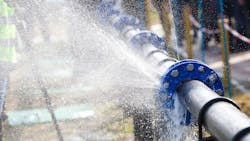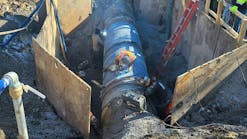Water is a precious resource, yet it is lost worldwide on a vast scale. According to the World Bank, non-revenue water loss costs an estimated USD$15 billion per year. In Europe, the average water loss is 26 percent — but some major cities both there and in North America have reported leakage rates of 30 percent or more. In some lower GDP countries, utilities have reported as much as 70 percent water loss.
Utility companies, needing to supply a growing population with water at a time when resource scarcity is high, face a major dilemma. By 2050, the population is estimated to grow by up to 70 percent, and water demand is projected to be 55 percent higher than in the year 2000. At the same time, four billion people will be living in water-stressed areas across the globe.
One way to tackle the problem of water loss is through reducing leakage. Minimizing water loss can ultimately be achieved through effectively monitoring and maintaining the integrity of water networks.
Current Threats to Pipelines
In the U.S., where there are over 2.2 million miles of underground drinking water pipes, a water main breaks approximately every two minutes and an estimated six billion gallons of treated is water lost each day.
There are a few reasons that typically cause water loss: aging pipelines are more susceptible to failure and, if made from steel, could experience corrosion that results in leaks; mechanical damage can cause ruptures; or water can be stolen by being siphoned off.
Pipeline aging is a substantial threat to water systems. For example, much of the water infrastructure in the United Kingdom is about 150 years old. In the U.S., the water pipelines are typically between 45 and 100 years old. For these aging networks, corrosion can be a problem. The effects of volatile weather — heavy rainfall or prolonged heat waves — also affect the soil. This, coupled with increasingly heavy-load road networks and ground movement, leads to strain on the pipelines and the water supply carried within them.
Theft is also a significant threat to water pipelines. An Interpol report has suggested that up to half of the world’s water supply is stolen annually. This is particularly prevalent in agricultural settings, where crops need constant irrigation.
Challenges to Existing Monitoring Technologies
Leak detection is generally divided into two different methods: internal based and external based monitoring.
Internal based monitoring systems, which infer the presence of a leak, have traditionally been used to check for leaks. These systems — such as mass balance and real time transient modeling — use computational pipeline monitoring to calculate different operational conditions. However, they tend to have very low sensitivity to small leaks and have long detectability times. As a result, leaks are often missed, or alarms are only raised after large quantities of water have already been lost.
Finding the source of a leak typically involves digging until wet soil is found. This process is more difficult in a city, of course, where pipes may be buried under roads or buildings. It quickly becomes a costly process, both through the water lost and the labor and equipment needed to find the source of the leak.
If the leak is in an isolated or hard to reach location, it could be many days before the utility company is aware, and, by the time an operator arrives on site, hundreds of gallons might have already been lost. If criminal activity were at play, the offenders would be long gone.
In contrast, external based systems, such as Fiber Optic Sensing, take direct measurements of different symptoms associated with a leak, such as noise. This provides a quicker detection of smaller amounts of water leakage, which can result in lower overall water loss.
Distributed Acoustic Sensing
One technology that can monitor water pipelines accurately, for both leak detection and disturbances related to attempted theft, is distributed acoustic sensing (DAS).
This photonic sensing technology essentially turns a fiber optic cable running alongside a water pipeline network into thousands of vibration sensors, able to detect any disturbances along the length of the pipeline.
The technology sends thousands of pulses of light along the fiber optic cable every second and monitors the fine pattern of light reflected back. When acoustic or vibrational energy — such as that created by a leak or by digging — creates a strain on the optical fiber, this changes the reflected light pattern.
By using advanced algorithms and processing techniques, DAS analyzes these changes to identify and to categorize any disturbance. Each type of disturbance has its own signature and the technology can tell an operator what happened, exactly where it happened, and when it happened, in real time.
Finding Faults Fast
DAS effectively provides an invisible smart barrier along the entire length of a pipeline, which can accurately detect and alarm leaks of different sizes, while providing their position along and around the water pipeline. DAS can detect vibrations caused by water being forced through a pipeline rupture, or by ground displacement associated with small leaks in pipelines that would otherwise remain undetected.
DAS can detect leaks as small as 20 liters per minute, from openings as small as 1 mm, significantly reducing the total water lost in these instances.
Maintaining Network Integrity
Maintaining pipeline network integrity and protecting against leaks and malicious theft are the biggest priorities for utility companies, due to the efficiency improvements that can be made and resulting cost savings. By gaining real-time visibility of the integrity of their entire network, water companies can protect against water loss, and can safeguard their assets and bottom lines while reducing risk.
DAS provides a critical layer of additional intelligence, thanks to its continuous monitoring, and can detect and pinpoint the location of multiple threats simultaneously, such as small leaks and third-party interferences. This technology can also be integrated with existing monitoring systems to complement them.
Combining information gathered from multiple monitoring and maintenance sensors into an overarching view gives water companies a fully-detailed understanding of what is happening on a water pipeline at any given moment. Only then can operators confidently maintain and respond to events before they become major incidents. WW
References
1. “INTERPOL-UNEP Strategic Report: Environment, Peace and Security, a Convergence of Threats,” INTERPOL, December 2016.
About the Author: Pedro Barbosa is a product owner for pipelines at Fotech. He works closely with pipeline operators, EPCs, and fiber optic integrators globally to develop and deliver DAS solutions for monitoring and protecting pipelines.
Published in WaterWorld Magazine, April 2022.



